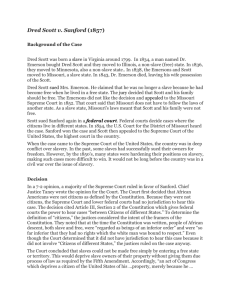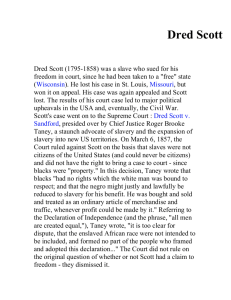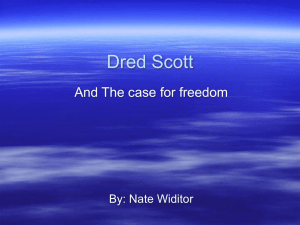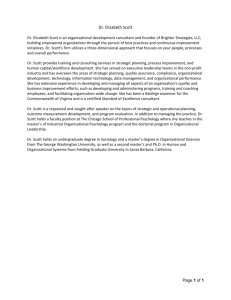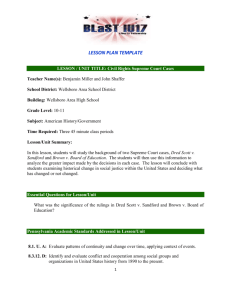Dred Scott Case Timeline - St. John Vianney High School
advertisement
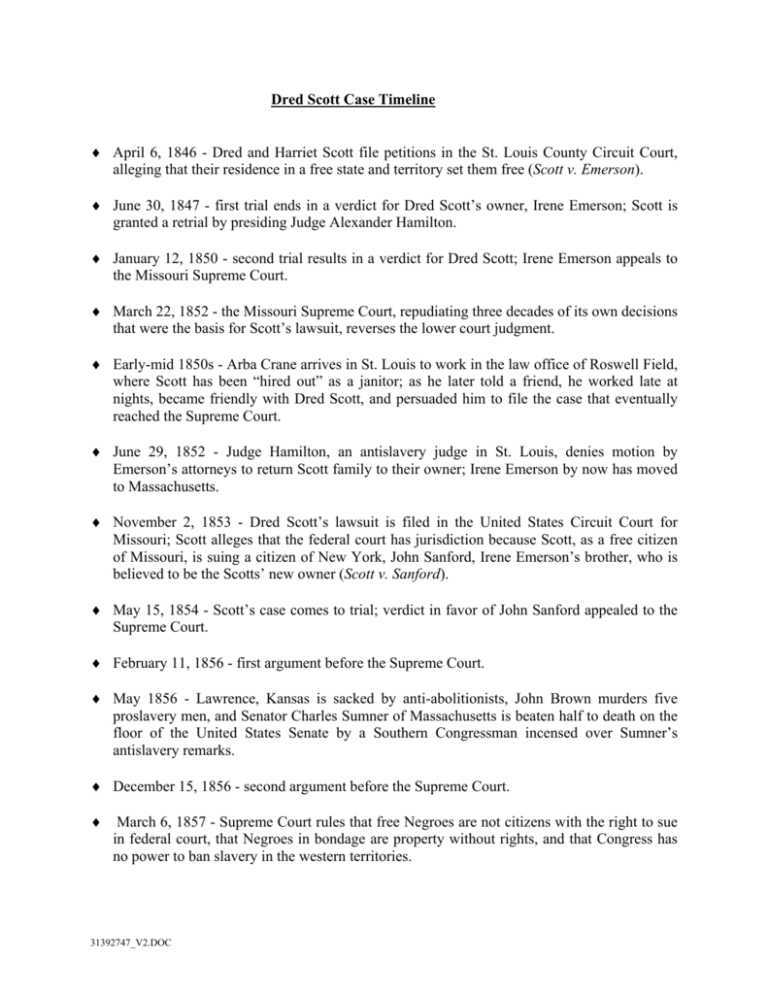
Dred Scott Case Timeline ♦ April 6, 1846 - Dred and Harriet Scott file petitions in the St. Louis County Circuit Court, alleging that their residence in a free state and territory set them free (Scott v. Emerson). ♦ June 30, 1847 - first trial ends in a verdict for Dred Scott’s owner, Irene Emerson; Scott is granted a retrial by presiding Judge Alexander Hamilton. ♦ January 12, 1850 - second trial results in a verdict for Dred Scott; Irene Emerson appeals to the Missouri Supreme Court. ♦ March 22, 1852 - the Missouri Supreme Court, repudiating three decades of its own decisions that were the basis for Scott’s lawsuit, reverses the lower court judgment. ♦ Early-mid 1850s - Arba Crane arrives in St. Louis to work in the law office of Roswell Field, where Scott has been “hired out” as a janitor; as he later told a friend, he worked late at nights, became friendly with Dred Scott, and persuaded him to file the case that eventually reached the Supreme Court. ♦ June 29, 1852 - Judge Hamilton, an antislavery judge in St. Louis, denies motion by Emerson’s attorneys to return Scott family to their owner; Irene Emerson by now has moved to Massachusetts. ♦ November 2, 1853 - Dred Scott’s lawsuit is filed in the United States Circuit Court for Missouri; Scott alleges that the federal court has jurisdiction because Scott, as a free citizen of Missouri, is suing a citizen of New York, John Sanford, Irene Emerson’s brother, who is believed to be the Scotts’ new owner (Scott v. Sanford). ♦ May 15, 1854 - Scott’s case comes to trial; verdict in favor of John Sanford appealed to the Supreme Court. ♦ February 11, 1856 - first argument before the Supreme Court. ♦ May 1856 - Lawrence, Kansas is sacked by anti-abolitionists, John Brown murders five proslavery men, and Senator Charles Sumner of Massachusetts is beaten half to death on the floor of the United States Senate by a Southern Congressman incensed over Sumner’s antislavery remarks. ♦ December 15, 1856 - second argument before the Supreme Court. ♦ March 6, 1857 - Supreme Court rules that free Negroes are not citizens with the right to sue in federal court, that Negroes in bondage are property without rights, and that Congress has no power to ban slavery in the western territories. 31392747_V2.DOC ♦ May 26, 1857 - Dred Scott and his family freed -- newspaper reporters discover that Irene Emerson, after leaving St. Louis, had married an abolitionist Congressman; outraged public opinion forces Irene Emerson to free the Scott family; Arba Crane draws up the emancipation documents. ♦ 1858 - Lincoln-Douglas debates, primarily about the Dred Scott case and its implications. ♦ April 1860 - Democratic Party breaks apart when Southern delegations march out of the Party’s Convention in anger over the rejection of their demand that the party platform include a national slave code based on Dred Scott. ♦ November 6, 1860 - Lincoln wins the election with a minority of the popular vote, the majority of votes having been mainly divided between candidates from the broken pieces of the Democratic Party. ♦ March 4, 1861 - Lincoln sworn in as President by Chief Justice Roger Taney, who wrote the Dred Scott opinion. Shortly, the Civil War begins. 31392747_V2.DOC 2


